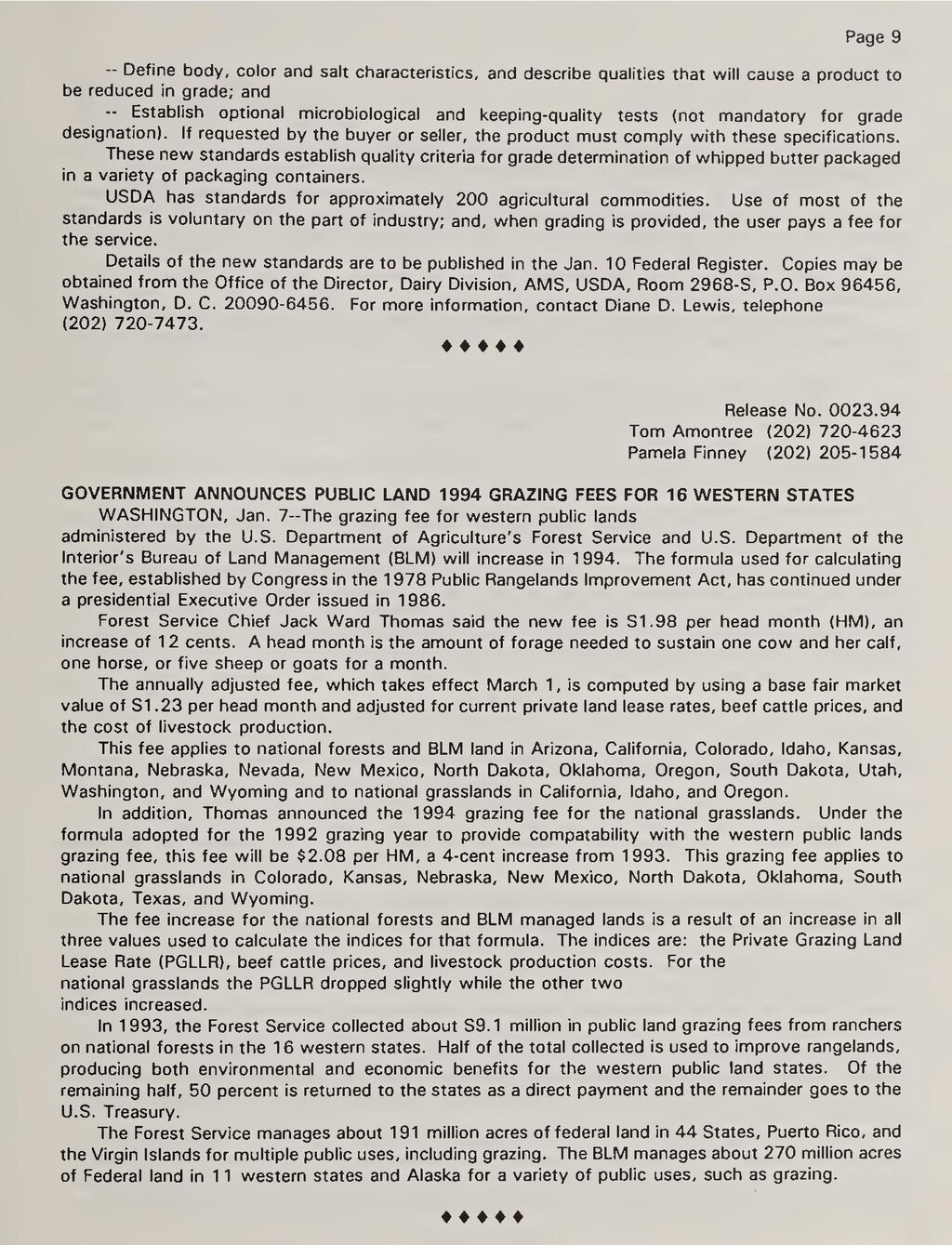- -- Define body, color and salt characteristics, and describe qualities that will cause a product to be reduced in grade; and
- -- Establish optional microbiological and keeping-quality tests (not mandatory for grade designation). If requested by the buyer or seller, the product must comply with these specifications.
These new standards establish quality criteria for grade determination of whipped butter packaged in a variety of packaging containers.
USDA has standards for approximately 200 agricultural commodities. Use of most of the standards is voluntary on the part of industry; and, when grading is provided, the user pays a fee for the service.
Details of the new standards are to be published in the Jan. 10 Federal Register. Copies may be obtained from the Office of the Director, Dairy Division, AMS, USDA, Room 2968-S, P.O. Box 96456, Washington, D. C. 20090-6456. For more information, contact Diane D. Lewis, telephone (202) 720-7473.
♦ ♦ ♦ ♦ ♦
Release No. 0023.94
Tom Amontree (202) 720-4623
Pamela Finney (202) 205-1584
GOVERNMENT ANNOUNCES PUBLIC LAND 1994 GRAZING FEES FOR 16 WESTERN STATES
WASHINGTON, Jan. 7--The grazing fee for western public lands administered by the U.S. Department of Agriculture's Forest Service and U.S. Department of the Interior's Bureau of Land Management (BLM) will increase in 1994. The formula used for calculating the fee, established by Congress in the 1978 Public Rangelands Improvement Act, has continued under a presidential Executive Order issued in 1986.
Forest Service Chief Jack Ward Thomas said the new fee is S1.98 per head month (HM), an increase of 12 cents. A head month is the amount of forage needed to sustain one cow and her calf, one horse, or five sheep or goats for a month.
The annually adjusted fee, which takes effect March 1, is computed by using a base fair market value of S1.23 per head month and adjusted for current private land lease rates, beef cattle prices, and the cost of livestock production.
This fee applies to national forests and BLM land in Arizona, California, Colorado, Idaho, Kansas, Montana, Nebraska, Nevada, New Mexico, North Dakota, Oklahoma, Oregon, South Dakota, Utah, Washington, and Wyoming and to national grasslands in California, Idaho, and Oregon.
In addition, Thomas announced the 1994 grazing fee for the national grasslands. Under the formula adopted for the 1992 grazing year to provide compatability with the western public lands grazing fee, this fee will be $2.08 per HM, a 4-cent increase from 1993. This grazing fee applies to national grasslands in Colorado, Kansas, Nebraska, New Mexico, North Dakota, Oklahoma, South Dakota, Texas, and Wyoming.
The fee increase for the national forests and BLM managed lands is a result of an increase in all three values used to calculate the indices for that formula. The indices are: the Private Grazing Land Lease Rate (PGLLR), beef cattle prices, and livestock production costs. For the national grasslands the PGLLR dropped slightly while the other two indices increased.
In 1993, the Forest Service collected about S9.1 million in public land grazing fees from ranchers on national forests in the 16 western states. Half of the total collected is used to improve rangelands, producing both environmental and economic benefits for the western public land states. Of the remaining half, 50 percent is returned to the states as a direct payment and the remainder goes to the U.S. Treasury.
The Forest Service manages about 191 million acres of federal land in 44 States, Puerto Rico, and the Virgin Islands for multiple public uses, including grazing. The BLM manages about 270 million acres of Federal land in 11 western states and Alaska for a variety of public uses, such as grazing.
♦ ♦ ♦ ♦ ♦
